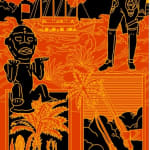
 The Route #1
The Route #1
 The Route #2
The Route #2
 The Route #3
The Route #3
 The Route #4
The Route #4
Elia Nurvista
Further images
The Route is a series of four batik panels first exhibited at the WereldMuseum in Amsterdam, retelling the history of the oil palm’s migration and displacement. Native to West and Southwest Africa, palm oil was discovered by Europeans in the 15th century and brought to Europe through slavery. Despite its potential, African communities refused to cultivate it, leading Dutch colonial powers to create large oil palm plantations in Sumatra and the Malay Peninsula. The work also touches on how Dutch textile companies mass-produced and commercialized Javanese batik in the 19th century, with the largest markets in Africa.
Using textiles to tell these stories, the artist explores the complex history of knowledge and commodity appropriation from imperialism to modern globalization. The work also critiques the act of collecting by ethnographic museums, questioning their role in this history.
The Route 是一组由四幅蜡染布组成的作品系列,首次在阿姆斯特丹的世界博物馆展出,重述了油棕迁徙与流离失所的历史。油棕原产于西非和西南非洲,15世纪被欧洲人发现,并随着奴隶贸易传入欧洲。尽管油棕具有巨大的经济潜力,非洲社区却拒绝大规模种植,迫使荷兰殖民者在苏门答腊和马来半岛建立了大规模的油棕种植园。这件作品还反映了19世纪荷兰纺织公司如何将爪哇蜡染大规模生产和商业化,成为非洲当时最大的市场。
通过纺织品这一媒介,艺术家勾画了从帝国主义到现代全球化中,知识与商品的被剥夺与挪用的复杂历史。作品也对民族志博物馆的收藏行为提出质疑, 质疑它们在这段历史中所扮演的角色。










